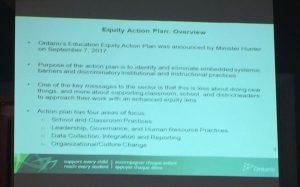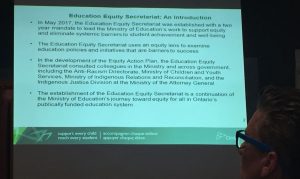The Ministry of Education’s Education Equity Action Plan, released in September 2017, complements and builds on the 2009 Equity and Inclusive Education Strategy by laying out objectives and actions in four areas:
- School and classroom practices;
- Leadership, governance and human resource practices;
- Data collection, integration and reporting; and
- Organizational (i.e. Ministry) culture change.


Christa Freiler, research and policy support to our project, studied the Equity Action Plan in advance of the November 3rd meeting. Noting the encouraging focus of the Equity Action Plan on systemic barriers to equity and inclusion (i.e. those that are built into the system), Christa identified the following ways that the SPNO’s KNSWB Project might contribute to meeting the objectives of the Equity Action Plan:
- Provide socio-economic status (SES) diversity through knowledge mobilization and, if needed, development of resources and professional development. The action plan acknowledges partnerships with organizations to “provide in-depth professional development …on implicit biases and to build capacity” to support students and to combat issues such as Islamophobia, anti-Semitism, racism and homophobia (p. 5). SES diversity and classism are not explicitly identified although poverty and low SES are identified as concerns.
- Assist in assessing school library holdings for sensitivity to SES diversity sensitivity. The action plan identifies the need to assess learning resources (both traditional and electronic) to ensure that they are accessible and reflect diversity. SPNO could consider partnering with an organization, such as the Ontario Library Association, to address this action item (see p. 23)
- Using an SES diversity lens, to work with schools/school boards “to examine and address systemic barriers that limit students’ ability to pursue their chosen pathways after graduation” (p. 22). For example, what are the implications of streaming in general or even more specifically, if the “academic vs applied” decision is delayed beyond Grade 9?
- Help to identify strategies to reach out to parents who may be disengaged from the education system (see. p. 16). This is the kind of knowledge mobilization that is not limited to a written or other media product, but can be used with parents and communities in training or planning sessions.
- Identify and provide evidence-based research on additional areas that are not explicitly addressed in the action plan but that impede equity and inclusion of low SES students, such as student fees and school fundraising. Should this be approached as a human rights issue, as is done for other diversity areas?
Zubeida Vahed and Lisa Amin, two officials with the newly organized Education Equity Secretariat, presented to the project equity champions in November on the planned work of the Secretariat and the issues that it is addressing. Questions and discussion followed.
How are structural barriers being addressed?
Two processes were provided as examples for how this is being addressed. The first was addressing the shortcomings of seniority amongst teachers. The second example was looking at the Safe Schools Act and how this removed power from teachers who had an effective rapport with students and pushed out individuals from lower SES families.
How are students and parents made aware of human rights policies in the schools?
The Ministry will be releasing material on the subject of human rights policies by September 2018. Fact sheets will be handed out to parents and posted in classrooms and there will be an unveiling event to present this new material.
How is marginalization being addressed in the northern parts of Ontario?
This question was not directly addressed however it brought up the conversation of intersectionality and how, although marginalization can be race-based, it often is the result of several social factors that contribute to marginalizing an individual or group.
What is being done about collecting more data?
There are various forms of data being collected separately for various purposes. This data, however, is all brought together at the Ministry level and then examined for links. The Ministry of Education representatives stated that this data collection would be mandatory for boards although the participation of students and parents in providing information will be voluntary.
The Ministry’s Equity Action Plan is a very top-down approach, what is being done to develop a community connection?
Concern was expressed that there is no clear strategy or plan to engage communities on the ground in the Equity Action Plan. Participating in sessions such as this one with community people and educators from across the province is an example of one kind of outreach and connection.